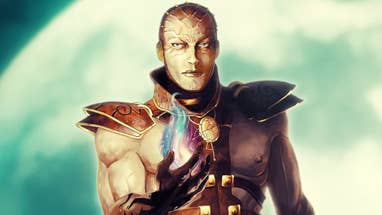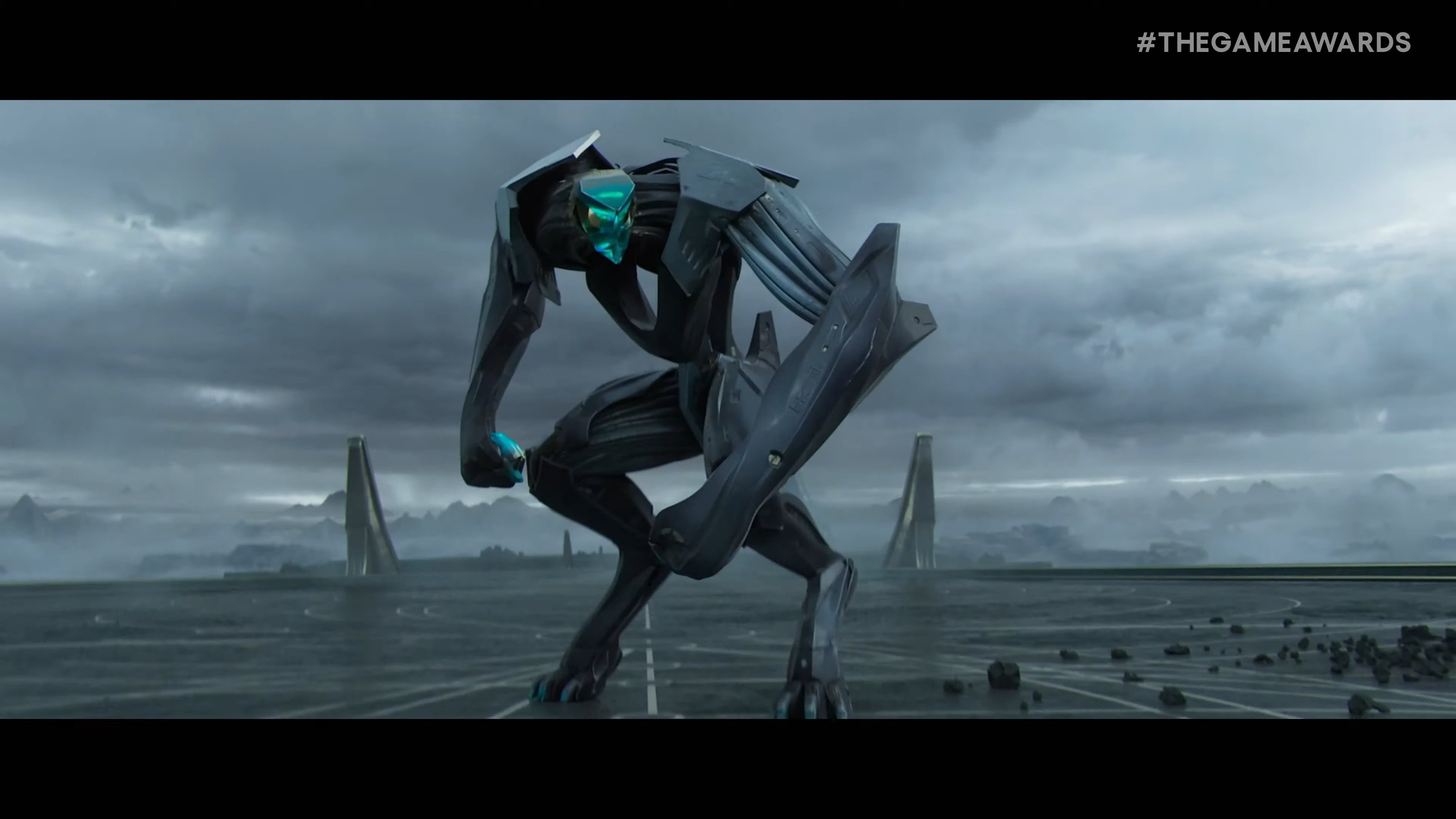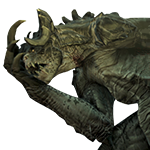If Anthem is the "anti-BioWare game", then James Ohlen is correcting the balance
The hugely influential design director talks Baldur’s Gate, his next RPG, and the abandonment of the BioWare model.

Feature by Jeremy Peel Contributor
Published on Oct. 9, 2023
“Baldur’s Gate II set the model, and I obviously loved that model,” says James Ohlen. “But there were a ton of people at BioWare who didn’t like it.” During leadership meetings over the course of the Canadian designer’s 22 years at the RPG studio, he’d sometimes feel totally outnumbered when talking about the importance of story. “Game developers don’t get into the industry to create stories, they get into the industry to create games,” he says. “And so there’s this conflict between game developers and story - my entire career it's been a constant fight.”
Ohlen picked his side early. He was telling BioWare stories even before he joined the company. The meeting of Minsc and Boo, one of the most enduring partnerships in PC gaming, came about in a tabletop Dungeons & Dragons game he ran as a teenager. Then a comic book store manager, he took advantage of his premises to guide no fewer than three concurrent D&D groups through their campaigns. “I didn’t really have much of a life outside of Dungeons & Dragons,” he says.
BioWare programmer Cam Tofer played Minsc in one of those campaigns, “as a guy who’s basically been knocked on the head too many times in fights”. A merchant NPC of Ohlen’s invention sold him Boo, the miniature giant space hamster, in an apparent scam. Tofer ran with it, declaring that Boo would be Minsc’s animal companion, and holding one-sided conversations with the confidant that lived in his pocket. “In my campaign he was just a hamster,” Ohlen says. “I always thought of him as just a hamster.”
Image credit: Beamdog
Back then, in the early 90s, there were no game design degrees, but Ohlen had dedicated himself to the next best thing. DMing proved to be an intensive training course in giving players agency and immersing them in another world - and his local reputation as a story wrangler landed him a job working on Baldur’s Gate. It’s a similar origin story to that of David Gaider, another D&D head who was plucked from the hotel industry to tell tales about vampires and druid groves.
“Have you ever read Malcolm Gladwell on the 10,000 hour rule? I think by the time I got hired by BioWare, I had done 20,000 hours of dungeon mastering,” Ohlen says. “It was ridiculous. I owe a lot to D&D. My friendships, my career, my mental stability.”
BioWare co-founder Ray Muzyka encouraged Ohlen to dig into the huge binders that contained the details of all the player characters and NPCs in his campaigns, and to let them spill out into the world of Baldur’s Gate. “I hadn’t intended to do that,” Ohlen says. “It seemed narcissistic. But he was right. Once I started using them, I started getting things done real fast. All the characters had personalities that I already knew.”
Those tabletop campaigns turned out to be accidental writers’ rooms - producing distinct personalities that reflected the voices of their individual players. From the binders came some of Baldur’s Gate’s most beloved companions, like Minsc and the egotistical conjurer Edwin, as well as its villains - leading all the way up to the sequel’s Hannibal Lector-esque antagonist, Jon Irenicus.
That said, inspiration for Baldur’s Gate II’s much deeper companion stories came from an unlikely source. During a freezing winter smoke break in Edmonton, an Interplay producer named Dermot Clarke mentioned that Baldur’s Gate’s characters weren’t nearly as developed as those in Final Fantasy VII.
Finval Fantasy VII's favourite boy Cloud, in the remake from 2020 | Image credit: Square Enix
“I’m very competitive,” Ohlen says. “I went and played Final Fantasy VII and was like, ‘Oh my good god, these characters make ours look like a bunch of cardboard cutouts. This is terrible.’” The disparity convinced BioWare to up their game, leading to the complex journeys of companions like Jaheira - the grieving wife and activist, whose sense of duty has been shaken by so much loss. Despite Ohlen’s distaste for the way SquareSoft’s RPGs played, he continued to be influenced by their character work - all the way up to Knights Of The Old Republic, which was partly inspired by the twist-laden Chrono Cross. That and Star Wars, of course.
“I actually totally, entirely ripped off The Empire Strikes Back in such blatant fashion,” Ohlen says. “You basically go to face the dark lord by yourself, and then you get into a lightsaber fight with him, and he kicks your ass. And then, after kicking your ass, he does the big twist. Then you don’t die because you’re rescued by your friends on the Millennium Falcon - I mean, the Ebon Hawk. It’s beat by beat the same thing.”
Of course, KOTOR’s plot twist didn’t feel familiar to players because it impacted not Luke Skywalker but them personally. For those who don’t know - and spoiler warning, if so - it revealed that your character was in fact a former Sith Lord, their memory wiped by the Jedi Council. In an RPG genre rooted by knowing your avatar down to their last stat, having your identity ripped out from under you felt genuinely radical. BioWare had succeeded in making its biggest setpiece not a battle, but a revelation. And in the process, it proved that BioWare storytelling was packed with the kind of explosive potential a publisher could bank on.
“If I was to go back in time to give my 2006 self some advice it would be, ‘Don’t try to make the game so long that you can fill up 200 hours. Instead, keep it shorter.’”
After the sale of the company to EA in 2007, Ohlen was put in charge of creative development on a Star Wars MMO, The Old Republic. It was BioWare’s next great hope, and an enormous undertaking - involving the founding of a brand new studio in Austin, Texas. At launch, it featured eight story campaigns which unfolded across 19 planets. In 2011, executive producer Rich Vogel told Fast Company that The Old Republic hosted “the most content in a video game ever”. Looking back, Ohlen views that as a fundamental problem.
“If open-world is the enemy of storytelling, multiplayer is the arch-villain,” Ohlen says. “If I was to go back in time to give my 2006 self some advice it would be, ‘Don’t try to make the game so long that you can fill up 200 hours. Instead, keep it shorter.’” With less ground to cover, the Austin team could have committed more resources to its Flashpoints - story-heavy missions which forefronted the difficult decision-making and tight encounter design that had elevated previous BioWare games. “Everyone wanted Knights of the Old Republic Online, and it felt more like World Of Warcraft with Star Wars spray-painted on it and some BioWare juice thrown in,” Ohlen says. “Even though the Metacritic was pretty good, it wasn’t new enough to really take off.”
At this point, a Knights Of The Old Republic 3 directed by Ohlen would be “not great”, he says. “Because I’m all Star Wars’d out. I have nothing else to say about Star Wars. But if a whole new studio does KOTOR 3 that loved KOTOR, that could be an amazing game. So hopefully Disney makes that happen. But probably not, because executives around there are all probably going, ‘It’s too hardcore.’” Ohlen still remembers the efforts he made to convince EA boss John Riccitiello that fantasy was a genre that could sell. “I had this whole PowerPoint presentation,” he says. “We have Lord Of The Rings! We have World Of Warcraft! We have Diablo!”
The year after The Old Republic’s launch, with the arch-villain of multiplayer still undefeated, development of Anthem began - and BioWare fought that increasingly costly battle for the better part of a decade. Those at the studio tired of the Baldur’s Gate model had the backing of EA, since a live service looter-shooter in the mode of Destiny could unlock years of long-term revenue beyond the reach of a single-player RPG. Or so the theory went. “It was always chasing the gigantic successes instead of leaning into what BioWare was good at,” Ohlen says. “It wasn’t just EA leaning on BioWare - there were lots of people in BioWare who wanted to do something different.”
Ohlen understood why others at the company would want to get away from a formula that empowered old hands like him and Gaider, and embrace one that empowered them instead. And he knew first-hand that freedom to experiment was what had set BioWare on the path to success decades before. Yet this new direction felt like an abandonment of the studio’s strengths. “Anthem was the ultimate expression of that,” Ohlen says. “It got away from everything. It’s kind of like the anti-BioWare game.”
Image credit: Rock Paper Shotgun/BioWare
Ohlen left in 2018, intending to retire from videogames altogether. “The big games have a formula and they don’t adjust it too much,” he says. “It’s very production driven, and I was like, ‘I’m not gonna get to make a game that I want to make at EA.’” He returned to the tabletop, putting together a new Baldur’s Gate adventure book featuring Minsc and the gang. But then Wizards Of The Coast called and flew him up to Seattle to discuss starting a new studio. Ohlen didn’t need or necessarily want a videogame development team under his wing - and that proved to be a perfect negotiating position.
“My demands were, ‘I only do this if I get to start my own studio in Austin, I get to choose who I hire, I get to choose exactly the kind of IP I want to make, no one’s gonna tell me anything about how to make the game.” At this point, Ohlen adopts a megalomaniacal tone, as if he were Baldur’s Gate baddy Sarevok, ascending to the throne of the dead god Bhaal. “I want control over absolutely everything! I want all the power!”
To his surprise, Wizards said yes, and Ohlen has been happily presiding over Archetype Entertainment ever since, building a new sci-fi RPG world without interference. “If you’ve seen the games I like to build, it’s that style of game,” he says. “But then it leans into the people and technology that I have available.” Ohlen won’t elaborate on what’s in his toybox, for fear of spilling secrets - but it’s worth noting that Mass Effect legend Drew Karpyshyn joined Archetype in 2020 as lead writer. “The feel in the studio reminds me of my early days at BioWare,” wrote Karpyshyn on his blog at the time. “I can feel the magic in the air.”
Magic and Wizards and science fiction - it’s the kind of atmosphere in which you could believe a hamster isn’t just a hamster, but something altogether sillier and more exciting. An act of collective imagination is happening, the binders are filled to bursting, and all we have to do is wait.
James and Drew working together, enjoying full creative freedom.
Now there's an iota of hope.
Don't you think that if they had some interesting vision, after these few years we would see something concrete?
They have no obligation to show something until they feel they're ready.
























:format(webp):no_upscale()/cdn.vox-cdn.com/uploads/chorus_asset/file/25141266/polygon_exodus_rpg_mass_effect_queen.png)

:format(webp):no_upscale()/cdn.vox-cdn.com/uploads/chorus_asset/file/25141273/polygon_exodus_archetype_spaceship_faster_than_light.png)
:format(webp):no_upscale()/cdn.vox-cdn.com/uploads/chorus_asset/file/25141271/polygon_exodus_archetype_enemy_combat.png)





![Glory to Codexia! [2012] Codex 2012](/forums/smiles/campaign_tags/campaign_slushfund2012.png)



